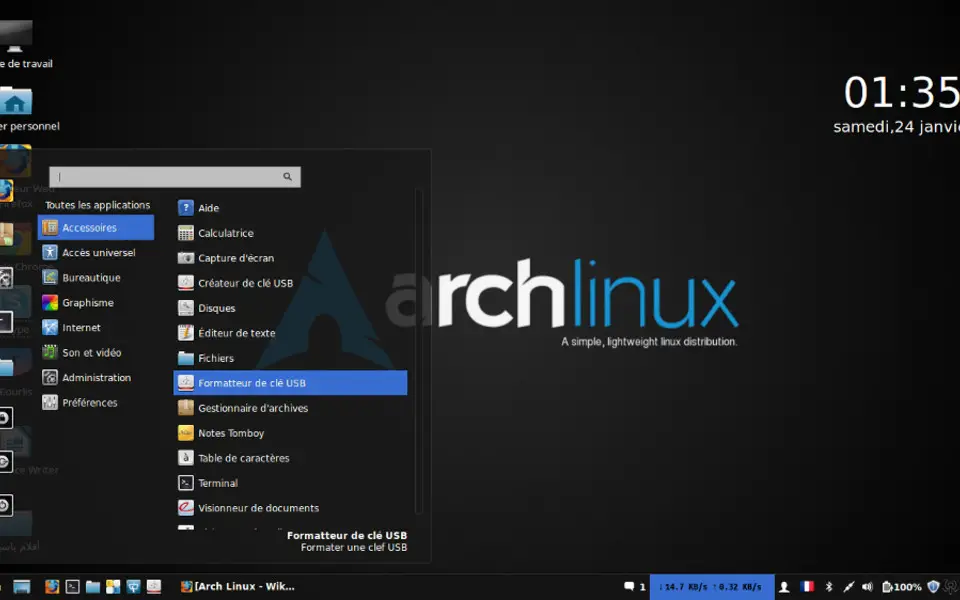

- #ARCH LINUX MAC OS X HOW TO#
- #ARCH LINUX MAC OS X MAC OS X#
- #ARCH LINUX MAC OS X INSTALL#
- #ARCH LINUX MAC OS X DRIVER#
- #ARCH LINUX MAC OS X FULL#
I've noticed that a lot of tech inclined folks eventually get to this point, and just leave Linux/Windows for MacOS. But the fact that I have to painstakingly set those things up outside of the box every time I reinstall, or if a backup fails, or it breaks the desktop, or whatever - I just stopped having interest in fucking with it. There are just a lot of little things that MacOS does for you, or does in the background, that if Linux did it - I probably never would have moved.
#ARCH LINUX MAC OS X DRIVER#
MacOS is more stable as a daily driver than any Arch distro I've run, and definitely more-so than any Debian based distro I've run. Plus, pretty much everyone in my personal life uses an iPhone, so iMessage and Facetime are big time incentives. I use a lot of third-party tools like Adobe and Microsoft related things, which I doubt, unless something like the Steam Deck takes off, will ever get proper support. It has all the features/utilities that I enjoy about Linux (because BSD), while having third party support that Linux will probably never get. If you installed Linux as the only operating system and replaced Mac OS X, you’ll need to reinstall OS X on your Mac if you want to leave Linux behind.Effectively the same reason I popped over from Linux to Mac.
#ARCH LINUX MAC OS X MAC OS X#
After the partitions are deleted, you can enlarge your Mac OS X partition afterwards from the Disk Utility in OS X to reclaim the space used for Linux. You can also boot from your Linux USB media and use the GParted partition manager to remove these partitions. Boot into OS X, open the Disk Utility, and delete your Linux partitions. If you decide you no longer want to dual boot Linux on your Mac, you can remove Linux fairly easily.
#ARCH LINUX MAC OS X HOW TO#
RELATED: How to Wipe Your Mac and Reinstall macOS from Scratch Other users have probably dealt with the same problems before you, and they’ve probably written guides to making everything work. If something doesn’t work, you may have to perform some Google searches with the model and year of your Mac as well as the name and version of the Linux distribution you’re using. This depends on the version of Linux you use, how recent it is, and what Mac hardware you’re using. Whenever you boot your computer, you’ll have the ability to choose between Mac OS X and Linux on the rEFInd boot manager screen.ĭepending on your Mac, some hardware components may not work perfectly on Linux. The installation process should otherwise be normal. Be sure to select the “Install Ubuntu alongside Mac OS X” option instead of overwriting your Mac OS X system with Ubuntu.
#ARCH LINUX MAC OS X INSTALL#
On Ubuntu, launch the Install Ubuntu application from the desktop and install Ubuntu as you normally would. Launch your Linux distribution’s installer and go through the installation process. Select the USB or disc drive containing the Linux system and boot it on your Mac. Restart your computer and rEFInd will appear. Burn the ISO to disc or follow Ubuntu’s official instructions to create a bootable USB drive from the ISO file. For example, if you’re using Ubuntu, you’ll need to download an Ubuntu ISO file - download the “64-bit Mac” version.

You’ll need Linux installation media to continue. Drag and drop the handle on the partition volume or enter a final size for the partition and click Partition to partition it.ĭon’t create a new partition after shrinking your current partition - just leave the space empty for now. Ubuntu’s system requirements say it requires at least 5 GB of space, but something like 20 GB is much more reasonable. How much space you want for Linux is up to you. Shrink the current Mac OS X partition to make space for your Linux system. RELATED: Beginner Geek: Hard Disk Partitions Explained Select your Mac’s hard drive in the list on the left and select Partition on the right. From within Mac OS X, press Command + Space, type Disk Utility, and press Enter to open the Disk Utility. You’ll now need to resize your Mac OS X system partition to make room for your Linux distribution of choice.

You should see the rEFInd boot manager screen.
#ARCH LINUX MAC OS X FULL#
Shut down your Mac - a full shut down, not a restart - and boot it back up again.


 0 kommentar(er)
0 kommentar(er)
